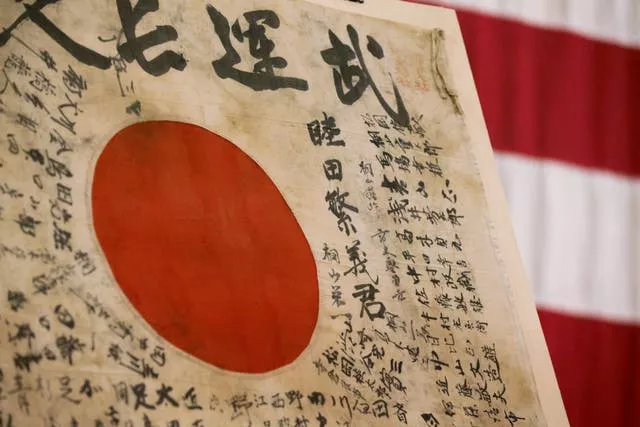A flag carried by a Japanese soldier killed in action during the Second World War was handed over on Thursday by the USS Lexington Museum in Texas to a nonprofit organisation for return to the man’s family.
Known as a Good Luck Flag, it is covered with the signatures of Shigeyoshi Mutsuda, his family and friends.
The Corpus Christi museum where it was displayed for 29 years gave the flag to the Obon Society, a nonprofit organisation that has returned about 500 similar flags, known as non-biological human remains, to descendants of Japanese service members killed during the war.

“This is all that’s left of this man to return to his family,” said Obon Society co-founder Rex Ziak.
“They feel exactly the same as Americans when they receive the bones or teeth” of relatives who were identified and returned decades after being killed in war, he said.
Hirofumi Murabayashi, consul general of Japan in Houston, expressed appreciation to the museum for willingly handing over the flag and said the transfer symbolises the friendship between the US and Japan.
“He (Mutsuda) was killed in action and his body was not found … there’s no remains,” Mr Murabayashi said.
The funeral of Mr Mutsuda’s wife, who died in May at age 102, has been delayed until the flag is returned, Mr Murabayashi said.
The flag, known as Yosegaki Hinomaru, has been displayed at the museum aboard a Second World War aircraft carrier since it was donated in 1994, according to museum director Steve Banta.
He called the donation routine and said the museum has been unable to locate who gave the flag to the museum because of what he called record-keeping issues at the time.

Mr Mutsuda’s signature on the flag was recognised by one of his sons, now 82, who saw an image of the flag and also recognised the signatures of other family, friends and neighbours, confirming the flag was carried by his father, according to Mr Ziak.
The signatures match those in a family photo of Mr Mutsuda holding the flag and surrounded by family members before he left for war, Mr Ziak said.
Who found the the flag and under what circumstances is not known, Mr Ziak said.
“Often soldiers will search battlefields for sensitive information, like maps, and find flags and other things and collect them as souvenirs,” Mr Ziak said.
The flags could be rolled and carried easily and service members “brought them home by the thousands” as souvenirs, according to Mr Ziak.
The tale of how, or even where, such items were found is then often lost to the passage of time, according Mr Ziak, as the veterans return home and store them away until they are found after the service member’s death.
The flag will be returned to the two sons and daughter of Shigeyoshi Mutsuda in Tokyo later this month during a ceremony at a shrine to Japanese war dead in Tokyo.







